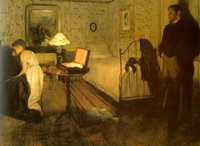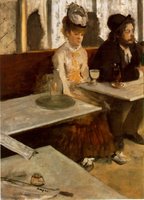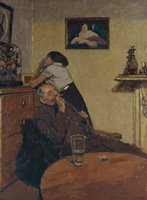The Destruction of Relationships
I've learned to tone down my "art talk" over the years. First, I've realized that I don't know anymore than anyone else who's done well in an art history class. Secondly, I've also realized that nothing sounds more pretentious than discussing contour lines and brush strokes. Mainly though, while once upon a time I was able to disguise my age by commenting on art, I've realized that the smartest adults I know don't discuss how smart they are all the time.
APK took me to the opening of the Degas, Sickert, and Toulouse-Lautrec exhibit at the Phillips Collection last night. I've always thought that there are two types of people who go to art openings- those who truly enjoy art and those who want to say they truly enjoy art. I was amazed to learn that I'm finally falling into the first group. With everything in my life consistently changing, my comfort zone has become art. I get excited being able to recall that Degas' statues were cast in bronze only after he died or that Toulouse-Lautrec was a deformed alcoholic. I don't even need to tell anyone this information anymore. It's like a box of Mac n' Cheese. It's easy for me to remember, and I can enjoy it without having to share it.
I wish the curator had included more detail on the change in society's attitude towards marriage and relationships at the turn of the 20th century. While pieces were included throughout the exhibit, I found the influence of a changing culture the most disturbing and interesting aspect of the show. The Rape by Degas, which was possibly drawn from the book Nana by Emile Zola, possibly illustrated a male character in Nana who kills his lover's wife to be with her. These artists were painting our world's slowing ability to commit to nothing. Today, we're familiar with hearing about divorce and falling out of love. Here's where it all began.
 From a discussion on The Rape:
From a discussion on The Rape:
"Degas highlights the somber room with a bright light shining on the open box on the table and the back of a woman crouching, her dress torn to expose her left shoulder. Some sources suggest that this painting was not about a rape, but about a novel published by Zola, in which the woman asks her lover to kill her husband, so that they can elope. "

APK was interested deeply in L'Absinthe by Degas. The Curator had chosen to display the critiquing of the painting from international newspapers circa 1876. Other than that, the main discussion was about the "unconventional perspectives, intensity of psychological expression, and blurring of social class distinctions." It's a popular painting entwined in our culture. One review described this woman as a slut. Today, this is not an uncommon sight. This is a woman left alone to drink away her heartbreak. Sadness in her eyes. Her years aged by heartbreak. Her face hardened by emotion. I view this painting as the recognition of love becoming a game people play. This is the beginning of the end of relationships.

From Wikipedia:
"Sickert's interest in Victorian narrative genres also influenced his best known work Ennui, in which a couple in a dingy interior gaze abstractedly into empty space,as though they can no longer communicate with each other."
This is the fear of any early-20s guy I know. Fear of becoming an old married couple. With no more love left to share. This is when that fear began to surface.
Couples in front of the fireplace with their five children and nicest clothes on were no longer what painters wanted to depict. In that regard, they must have felt that the image was too far from reality. Much as Woody Allen gave us movies in the 1970s about real people living real lives, as I would have liked to see the exhibit, painters of the late 1800s were showing a changed world full of hollow relationships and an increasing restlessness with finding a higher love.
So that's my depressing view of the show.
APK took me to the opening of the Degas, Sickert, and Toulouse-Lautrec exhibit at the Phillips Collection last night. I've always thought that there are two types of people who go to art openings- those who truly enjoy art and those who want to say they truly enjoy art. I was amazed to learn that I'm finally falling into the first group. With everything in my life consistently changing, my comfort zone has become art. I get excited being able to recall that Degas' statues were cast in bronze only after he died or that Toulouse-Lautrec was a deformed alcoholic. I don't even need to tell anyone this information anymore. It's like a box of Mac n' Cheese. It's easy for me to remember, and I can enjoy it without having to share it.
I wish the curator had included more detail on the change in society's attitude towards marriage and relationships at the turn of the 20th century. While pieces were included throughout the exhibit, I found the influence of a changing culture the most disturbing and interesting aspect of the show. The Rape by Degas, which was possibly drawn from the book Nana by Emile Zola, possibly illustrated a male character in Nana who kills his lover's wife to be with her. These artists were painting our world's slowing ability to commit to nothing. Today, we're familiar with hearing about divorce and falling out of love. Here's where it all began.
 From a discussion on The Rape:
From a discussion on The Rape:"Degas highlights the somber room with a bright light shining on the open box on the table and the back of a woman crouching, her dress torn to expose her left shoulder. Some sources suggest that this painting was not about a rape, but about a novel published by Zola, in which the woman asks her lover to kill her husband, so that they can elope. "

APK was interested deeply in L'Absinthe by Degas. The Curator had chosen to display the critiquing of the painting from international newspapers circa 1876. Other than that, the main discussion was about the "unconventional perspectives, intensity of psychological expression, and blurring of social class distinctions." It's a popular painting entwined in our culture. One review described this woman as a slut. Today, this is not an uncommon sight. This is a woman left alone to drink away her heartbreak. Sadness in her eyes. Her years aged by heartbreak. Her face hardened by emotion. I view this painting as the recognition of love becoming a game people play. This is the beginning of the end of relationships.

From Wikipedia:
"Sickert's interest in Victorian narrative genres also influenced his best known work Ennui, in which a couple in a dingy interior gaze abstractedly into empty space,as though they can no longer communicate with each other."
This is the fear of any early-20s guy I know. Fear of becoming an old married couple. With no more love left to share. This is when that fear began to surface.
Couples in front of the fireplace with their five children and nicest clothes on were no longer what painters wanted to depict. In that regard, they must have felt that the image was too far from reality. Much as Woody Allen gave us movies in the 1970s about real people living real lives, as I would have liked to see the exhibit, painters of the late 1800s were showing a changed world full of hollow relationships and an increasing restlessness with finding a higher love.
So that's my depressing view of the show.



0 Comments:
Post a Comment
<< Home